This is Robo from Chrono Trigger. Even if you’ve given that classic RPG half a baker’s dozen playthroughs, take a good look as if you were seeing him for the first time.
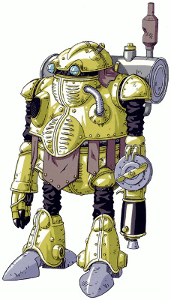
From a glance at him, anyone would think this character will feel significantly different from other party members. His arms are longer than humans’, he wears some kind of steam pack, his eyes are probably equipped with superior sensors and he doesn’t need to blink, and most importantly, he’s made of metal.
None of this translates to noticeable gameplay differences, though. He can take a hit better than Crono, but not immensely better. He’s the slowest party member, but still comparable to Marle’s speed. He’s strong, but Ayla’s stronger. You can even feed him potions like he has a digestive system. In short, Robo is a robot purely for story flavor. There’s nothing wrong with that and he’s a memorable and beloved character for good reason, but let’s compare him with other games’ takes on mechanical heroes.
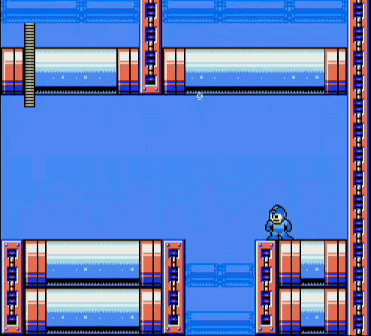
Very few games have more memorable water levels than the Mega Man series. While most game heroes struggle and flail in underwater settings, Mega Man runs and falls through water no differently than through air, giving us a sense that he’s a true robot with none of the buoyancy of flesh-and-fat humans. Mega Man also jumps like gravity doesn’t exist under the sea. Anyone playing a water level understands right away that they’re not controlling a human character.
On the other hand…
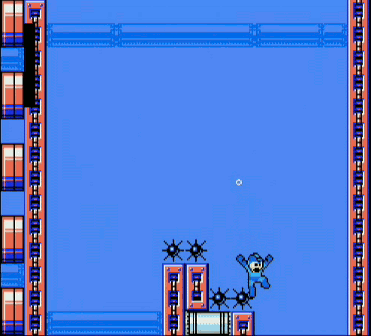
He breathes air bubbles underwater and dies when he touches spikes. Consider me crazy, but I always assumed that Mega Man was made of a tough metal. Maybe he’s not. He does have hair and his face appears to made out of skin or a very similar material, and if Dr. Light designed him to be anything like Roll then his arms and legs are the same as his face. Speaking of Roll, she stepped up to playable character status in Marvel vs. Capcom, Tatsunoko vs. Capcom, and most canonically, Mega Man Powered Up. She attacks with a wooden broom (or other miscellaneous but squishy objects in Powered Up) and it doesn’t immediately break when it hits enemy Robot Masters. Maybe they’re all made of soft metal.
At very least, though, I’m convinced that Mega Man’s helmet and enormous boots are made of a strong material, which raises one question: why does he die if his head or feet touch such thin spikes? If a hammer hits the sharp end of a nail, the hammer survives. I could probably pointless-debate this topic for hours, but since thinking ruins everything, I’ll cut to feeling. Mega Man feels like a robot in water and I appreciate the care that only energy-based powerups restore his health, but on land he runs and jumps like any platformer hero and his relationship with spikes makes me wonder. You’re still an icon, Mega Man, so chin up! If you played a pioneer role in the gaming industry from its early days, you can overlook the small stuff. We love you anyway.
Let’s go to a final group of the most convincing game robots.
***** Spoiler warning if you haven’t played Phantasy Star IV! *****
Toward the end of Phantasy Star IV, the player is given small leeway to choose one member of the final party from a selection of previous party members. Phantasy Star IV is a stellar RPG, but, like with Chrono Trigger, providing brutal challenge isn’t one of its strengths. Any party composition will do well enough. However, one possibility at least makes things slightly odd and unwieldy: bringing the android Demi on board while also being forced to use the android Wren.
In this game, almost no healing spells or healing items work on androids. They naturally self-repair 1 HP for each step on the overworld, which provides most of their healing and durability throughout dungeons, but in the pinch of extended boss fights, only one character can use heal-all magic that covers the full biological and artificial party—and you can’t include both him and Demi in the final group.
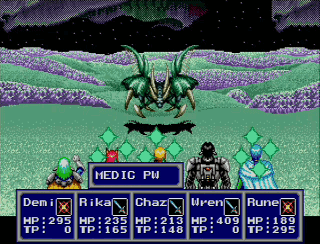
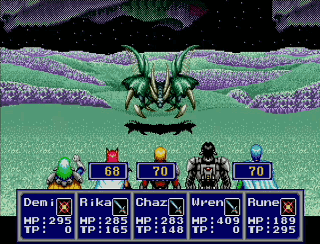
Even Demi’s own Medic Power doesn’t heal androids. She has to use her self-healing Recover ability and Wren has to use his Recover ability, which eats up two valuable turns.
This one seemingly small touch of demonstrating that magic designed to heal humans won’t affect androids makes all the difference in suspending audience disbelief and conveying the unique qualities of these two party members. Demi and Wren perfectly illustrate how to differentiate the gameplay feel of robots and humanoids.

Pingback: May the Fear Be With You | Game Design and Deconstruction